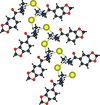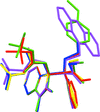issue contents
April 2015 issue

Cover illustration: In crystals of the new ionic complex [Ni(ac)(5,5'-dmbpy)2]ClO4·H2O (where 5,5'-dmbpy is 5,5'-dimethyl-2,2'-bipyridine and ac is acetate), neighbouring complex cations are linked by ![[pi]](/logos/entities/pi_rmgif.gif) -
-![[pi]](/logos/entities/pi_rmgif.gif) interactions forming zigzag chains. The magnetism of the complex at low temperature is dominated by single-ion anisotropy. See Farkasová, Cernák, Falvello, Orendác & Boca [Acta Cryst. (2015), C71, 252-257].
interactions forming zigzag chains. The magnetism of the complex at low temperature is dominated by single-ion anisotropy. See Farkasová, Cernák, Falvello, Orendác & Boca [Acta Cryst. (2015), C71, 252-257].
research papers








































 journal menu
journal menu




































